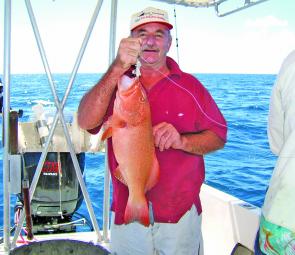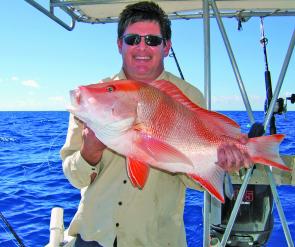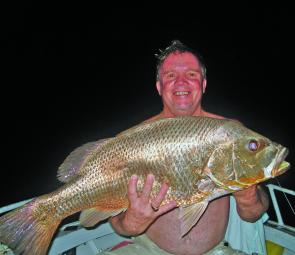March is historically the wettest month of the year in Cairns, and what’s going to happen this year is anyone’s guess.
The early onset of the wet has been interspersed with short patches of picture perfect weather, between prolonged periods of rain. Cyclone is the word on everyone’s lips this year, with low pressure systems spinning up a storm across the north. March could well bring more of the same.
The best plan of attack for March is to start a long term project that can be dropped readily should the weather take a turn for the better.
Mine will be replacing the ageing flooring in my tinnie. Rather than strip the lot out and do it in one hit, which is probably the most time efficient approach, I’m going to replace it in small stages that can be accomplished over a weekend. If the weather is shaping as foul, then my long time fishing buddy, Rob Cannon, and I will whip out a section and replace it, so should the following weekend pop up fine, we can hit the water.
We have decided to switch from carpeted marine ply to glassed ply, to reduce the wet weight and make it easier to clean and quicker to dry. It means that during the process the boat will look a bit of a dog’s breakfast, but who knows, March could be a real fizzer fishing-wise, and we greet April with a whole new floor.
The barra season got off to a great start, with some excellent catches reported when the weather allowed. Barra fever has subsided somewhat, with the serious anglers getting out there and giving it a crack while the less dedicated are still toying with the idea and waiting on perfect weather – a luxury in short supply during the wet.
As stated last month, the weather conditions, and more specifically the water conditions, will determine the best plan of attack for barra. Floods push most of the barra out the front following the bait, with others heading right upstream. Generally the bigger fish will be along the headlands, with smaller barra working their way up the creeks and channels.
Clear estuaries will see the fish on the snags and rock bars throughout the system, with the bottom couple of hours of the tide the best time to chase them with live baits or lures. Generally flicking the snags is better in summer, with trolling the deep water structure more suited to cool weather.
Fingermark have been around in good numbers this wet and are a great fish to target for those that like a bit of a challenge. If you are the occasional weekend fisho then they are probably best left for the more determined angler.
Live bait or lures are the only real options around Cairns, with live baiting generally the most productive. Trolling deep and super deep lures can help locate fingermark in water up to 10m, but deeper than that it’s really a job for the sounder.
Most fingermark are found close to heavy structure but not right on it. From years of diving in my youth I have observed that fingermark tend to work out away from structure, across the bottom, rather than sit in heavy cover like a coral trout. Positioning your boat off heavy structure so your live baits are on the bottom within a couple of metres up current of a bommie or rock, is ideal.
Having the fire power to pull up a brute of a fingermark when they head for cover is a challenge in itself. Some anglers fish with up to a 70lb handline for this approach, while rod and reel anglers tend to use braid in the 30-50lb range. In heavy country 30lb braid is giving any fish over 3kg all the advantage, so I generally fish 50lb braid with 50lb fluorocarbon leader. Fingermark are definitely line sensitive, so the lighter you go the more bites you’ll get but the fewer fish you’ll get to the boat.
The bait soakers will find the ever present mangrove jack in a feeding mood this month. Jacks don’t mind the dirty water and will happily stay in a flooded system, congregating where there is heavy structure underneath run-off water.
Find a patch of rocks or heavy snags with a creek or gutter emptying over it and the red devils will be sitting there ambushing bait as it flows into the main stream. Fresh is best when it comes to jack bait, with local eating quality squid the exception. Buy a kilo of eating squid as back up and if you can’t get fresh bait with the cast net you are still in the game.
Don’t bother refreezing the leftover squid, as it just won’t cut it as jack bait. Either look after it well and eat it that night, or feed it to the fish on departure for home.
Grunter are often about in March, with the top of the big tides around the new moon on the weekend of the 5-6 March and full moon on 19-20 March your best time to chase them. From first light until the top of the tide, head out on the weed and rubble flats.
The same bait options that work for jacks apply to grunter, but add prawns, especially freshly caught. They haven’t been treated with sodium metabisulphite to stop the gills and legs from going black. Yes, both bait and eating prawns are treated with this stuff! If bought prawns are the only option, reduce the chemical residual and improve their presentation by peeling the prawn, leaving the final joint of the tail intact.
The reef can be surprisingly productive in March, if the weather allows the opportunity to poke your nose out. Generally the conditions fluctuate between flat calm and cyclonic, with the occasional southeasterly ridge establishing itself along the east coast.
Night fishing is the preferred option in March, if for no other reason than it’s cooler. Hot, calm, days at the reef at this time of year can really test angler’s endurance. I have seen a number of cases of heat stroke while fishing the reef in March.
If you do opt for a daytrip make sure you have plenty of shade, apply sunscreen regularly, drink lots of water and stay cool by pouring cold water over your hat and shirt at regular intervals. A cloth Arafat style hat is idea for this. Once you decide to wet down you have to maintain the process or it can have the opposite effect with heat evaporating the water and slowly steam cooking you. A short spin in the boat also does wonders in the cooling department.
Generally, because of the high surface water temperature in March, the best fishing is in the deeper water, over 30m. Look for rubble grounds and focus on the mounds or gutters that will hold the fish. In flat calm conditions a drift across large rubble patches can help locate fish. March is like so many months in the north, where the weather conditions determine whether it’s a month of merriment or mayhem.
Reads: 2438
Rodney Wallis from Cairns caught this trout while fishing east of Cairns.

Quentin Pienaar, from Cairns was pretty happy with this red emperor taken while fishing at the reef off Cairns.

John Wedrat, from Cairns, with a brute of a fingermark he caught off a Cairns headland.




